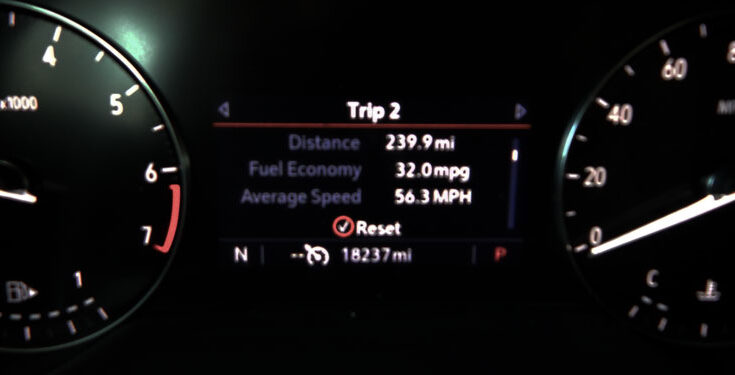Photo By Mike Bibb: My Buick’s instrument panel shows I averaged 32.0 mpg on a recent 240-mile trip. That equals about 7.5 gallons of gasoline consumed.
Column By Mike Bibb
For a guy who rarely drives himself, has a gas-powered classic Corvette, and probably couldn’t find his way across the D.C. Swamp with GPS assistance, it’s somewhat ironic President Joe is of the opinion we should all be driving electric vehicles in a few years.
Whether we want to or not.
Recently, I came across an article in Yahoo!Finance, Sept 27, 2023, detailing the struggles Ford’s CEO Jim Farley, experienced when driving a new electric F-150 Lightning pickup truck across stretches of highway in California.
In a posted video on X (Twitter), on Aug. 12, Farley lamented the fact that “charging has been pretty challenging.”
A corporate way of saying, “Allow plenty of time to find and use a charging station, because it may take a while.”
Obviously, unlike Chevron, Texaco, or Shell, there’s not an EV plug-in on every other corner. Especially, on the interstate highway system. And, the few there are often experience wait for delays, slow charges, or even out-of-service.
After waiting 40 minutes to receive a 40% charge at a station on I-5 in California, Farley remarked, “It was a really good reality check of the challenges that our customers go through.”
On the flip side, gasoline stations are everywhere and several tanks of gas can be pumped in 40 minutes.
I’m not sure what Mr. Farley was expecting, or why he thought a cross-country trip in an EV wouldn’t be much different than driving a gas rig.
Maybe, he was believing his own company’s ad agency.
In reality, all he had to do was think for a moment: “Gee, how come you never see any highway signs or truck stops advertising EV charging available?”
Like a lot of folks, I occasionally venture to Tucson and Phoenix for one reason or another, and I don’t recall seeing an EV charging site. Or, notice of one.
There’s some out there, I’m sure, but where?
Which makes me wonder, why would the boss, and board of directors of a major automobile manufacturing company encourage the development, production, and sales of electric cars and trucks without first taking into account the availability of facilities to recharge those vehicles.
If a shortage of charge sites exists, then what’s the point – and profit motive – of building EV vehicles?
Little wonder, Ford is presently sitting on several billion dollars of unsold EVs.
Sort of like putting the cart before the horse.
Furthermore, with sales gimmicks, incentives, and tax markdowns thrown in to entice a buyer, what good are these encouragements if the motorist can’t charge up when he wants to or needs to?
Farley’s comment that his experience was a check “of the challenges that our customers go through” was a bit disingenuous.
The simple fact of the matter is the customers wouldn’t be having these challenges if Ford had a little more foresight in anticipating them.
All Ford management had to do was drive a few miles in any direction from their assembly plants and count the number of EV charging stations they encountered. Even a $21 million-a-year CEO should be able to figure this out.
Nevertheless, the Big Three are in a race to see who can produce the most EVs because “It’s a green thing,” in addition to “Saving the planet,” and other climate change chatter.
As if electric cars are going to rescue the Polar Bears or prevent the Arctic Poles from melting, flooding Florida and Martha’s Vineyard.
No one ever seems to mention the electricity to charge these vehicles has to be produced and comes from a generating station. The generation stations usually operate on water, coal, oil, natural gas, or nuclear. Those elements have to be produced using equipment specially made for the tasks. The equipment manufacturers, in turn, rely upon others to obtain materials to build their equipment. And, so it goes. . .
In other words, the time and energy to supply electricity to charge and recharge these rolling wonders isn’t free by any stretch of the imagination.
And, as we all know, the customer ends up eventually paying for it.
Yet, apparently, that subject is rarely considered. How woke can you get?
The answer is obvious – in the business world, when unrestrained silliness begins to adversely impact the bottom line, company stockholders usually demand a change in direction.
Management reboot is often the case.
When over half the world could care less about electric cars and a clean environment, why is the United States expected to shoulder the burden in this effort? Not too many Chinese, Indian, or Russians seem concerned. Some days they can barely see through their own air pollution haze.
Yet, we’re being encouraged to ban the internal combustion engine in our country?
Try to convince a stranded motorist of the reliability of an EV, whose battery drained down before he realized he needed a charge, or couldn’t locate a charge site.
Not quite the same as running out of gas, grabbing a five-gallon fuel can, toting it back, pouring it into the tank – jumping in and driving off.
EVs may be the next hottest Wall Street gadget, promoted by legions of advertising agencies, liberal university professors, and government hucksters, but convincing the public of their necessity has, so far, not lived up to the hype.
As an example, would you attempt to take a four-day trip from Safford to Lake Havasu, or Las Vegas, in an EV and expect to make it home in time to go to work Monday morning?
There’s a lot of open desert between Southeastern Arizona and the Colorado River on the west side.
Actually, a similar incident happened to a Canadian family in August when they tried to travel in their F-150 Lightning from Winnipeg to Chicago.
Reportedly, the $85,000 vehicle failed to charge at two separate charging stations, requiring the family to rent a gas engine vehicle to get back home.
After incurring other frustrating incidents, the man later sold his Lightening EV, complaining that “electric vehicles are the biggest scam of modern times.”
It didn’t work out so well for Mr. Farley in his F-150 electric truck, either.
In fairness, I can see the need and attraction of electric vehicles in certain situations. But, they’re simply a tool, like any other machine, with abilities and limitations.
However, until their capabilities are improved, and an electric infrastructure is available to adequately service them, then it’s a bit premature to expect – or, demand – a society to switch from reliable petroleum-based transportation to electric modes of travel simply because some folks think it’s the cool thing to do.
To illustrate the discrepancy between the serviceability for EVs and gasoline-powered vehicles, I simply compared the number of charge sites, the number of available gas stations in Arizona, the number of registered vehicles, and the number of registered EVs in the state.
- According to Cronkite News, Dec. 27, 2022, Arizona currently has 903 EV charging stations with more than 2,400 charging ports – an average of 2.7 ports per station. I would imagine the majority of these stations are located in the Phoenix and Tucson areas.
- 2014 data by the Department of Energy records 2,339 gas stations in Arizona. Due to the state’s rapid growth since then, undoubtedly there are many more.
- In Fiscal Year 2022, Arizona MVD says there were 7,764,367 registered vehicles in the state.
- A report by the Alternative Fuel Data Center of the United States Department of Energy, on April 14, 2023, indicates Arizona has 40,740 EVs. DOE insists this translates into about 4 in every 1000 people in the state having an electric vehicle of some kind.
Four in 1000 people in Arizona own an EV – 0.4%; which might explain the absence of EV charging sites. There’s just not enough demand to warrant the expense of commercially installing them.
Back to the drawing board. Maybe, gasoline engines aren’t so bad. They’ve been getting more dependable and efficient for the last hundred years. Some vehicles can now average over 30 miles per gallon – at highway speeds.
My midsized Buick, for instance. On a recent 240-mile trip, I averaged 32 mpg. The tank holds 16 gallons, I believe. Which translates into about 512 miles per fill-up.
Not bad. In addition, I don’t have to install a special electrical plug at home, hunt for a charging station, or wait nearly an hour to top off the battery.
Plus, there’s the added benefit of grabbing a soda, snack, or lottery ticket at thousands of convenience stations while pumping a few gallons of 89 octane.
The opinions expressed in this editorial are those of the author.
Editor’s Note: The Gila Herald recently took a road trip from Safford to Salt Lake City in a Tesla and had no charging issues. That trip included going through Las Vegas both on the way to and back from Utah but other routes were available through Page if so desired.









